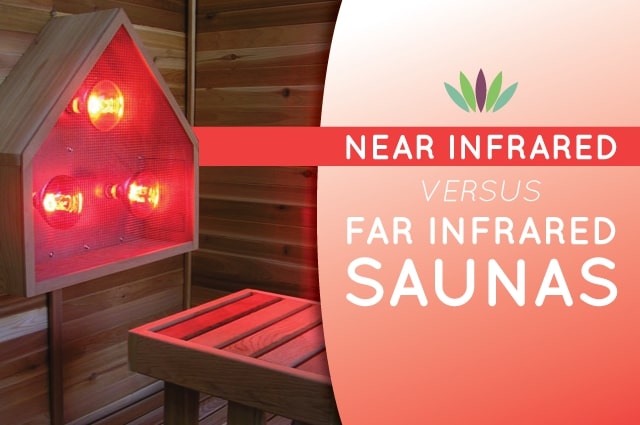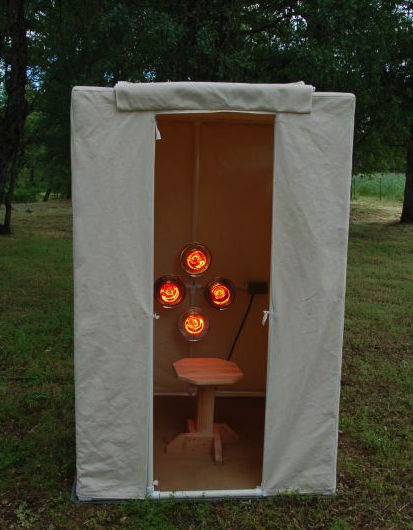Near Infrared Versus Far Infrared Saunas

Significant differences exist between near infrared versus far infrared saunas. In my experience as a physician, the near infrared lamp sauna is a far better sauna. At this time, I do not recommend the far infrared type of sauna at all.
Before we explore them, it is necessary to emphasize that the near infrared heat lamps can be added to many far infrared saunas to gain the advantages the lamps provide.
Get your own near infrared sauna from the Myers Detox Store.
1. Electromagnetically safer
 All electrically-powered saunas emit a small quantity of electromagnetic radiation due to their 110-volt wiring. This cannot be avoided, but is not a problem with saunas, since house wiring is everywhere in one’s home.
All electrically-powered saunas emit a small quantity of electromagnetic radiation due to their 110-volt wiring. This cannot be avoided, but is not a problem with saunas, since house wiring is everywhere in one’s home.
In a near infrared lamp sauna, the wiring is all on one wall, and the rest of the sauna is relatively far from the 110-volt house wiring. In a far infrared sauna, the emitters are scattered throughout the sauna, so the wiring goes all around the sauna, on all its walls. This means there is no place in the sauna that is further away from the electric wiring.
More important, however, is that far infrared saunas emit far more harmful electromagnetic fields. This has to do with the frequencies they are supposed to emit in the 4-15 micron range. This is similar to the emissions from cell phones and portable phones. It is in the microwave spectrum and quite harmful for some people who are sensitive to these frequencies. In fact, in some far infrared saunas, the EMF emissions actually reverse the polarity of the body. I do not have studies to prove this, but it is my observation.
Some companies claim to shield their far infrared emitters, but they cannot get rid of this radiation, as it is a feature of far infrared emission. The only way this type of sauna will not emit a small microwave field is if, in fact, the emitters are not putting out much far infrared radiation. In other words, it really cannot be avoided if the unit is actually putting out far infrared in the amount that they claim it is doing.
2. Penetrate more deeply
Near infrared lamp sauna energy penetrates inside the body slightly more deeply, and thus the infrared effects tend to be greater. Research indicates that near infrared lamp energy may penetrate up to 3-4 inches inside the body. Two reasons for this are:
- The near infrared heat lamps are far more powerful than most far infrared heat emitters. The heat lamps are 250 watts, whereas the emitters are usually of lower wattage in many cases.
- If the design I recommend is used, all three or four of the heat lamps are placed near each other on one wall. This further concentrates the heat source. In contrast, the emitters in most far infrared saunas are scattered around the sauna. This has the advantage that one need not rotate in the sauna to experience the benefits. However, it also means that the infrared energy is scattered around the sauna and not nearly as concentrated.
3. The spectrum emitted is as good or superior
 Visible radiation in the red, orange and yellow color range emitted by near infrared saunas appear to stimulate the lower body organs, including the organs of elimination – the liver, kidneys and large intestines – and the adrenal glands, among others. This is an excellent added benefit that is built into the near infrared lamp sauna.
Visible radiation in the red, orange and yellow color range emitted by near infrared saunas appear to stimulate the lower body organs, including the organs of elimination – the liver, kidneys and large intestines – and the adrenal glands, among others. This is an excellent added benefit that is built into the near infrared lamp sauna.
Also, an infrared lamp sauna emits mainly near and some middle infrared energy. Plenty of research supports the fact that this type of infrared is extremely beneficial for the human organism. It assists healing and regeneration of all the cells, glands and organs. It also relaxes the body more than far infrared, which is somewhat irritating to certain tissues.
4. The ability to focus more energy
The recommended near infrared sauna design offers certain other advantages such as the ability to focus the energy even more powerfully and to stimulate the more circulation. With a near infrared light sauna, one can easily move a body part closer to the heat lamps to provide more infrared to that part of the body. For example, one can sit so as to direct more energy to the liver, the sinuses or even to a painful ear or shoulder. This cannot be done nearly as effectively with a far infrared sauna.
The head is somewhat more sensitive to infrared, by the way. Thus, one should exercise caution regarding moving the head too close to any source of infrared energy. Limit this to no more than five minutes at a time during a session. Repeated short applications of infrared to the head area, for no more than five minutes or so every hour or so, appear to be very safe.
5. Uses much less electricity
As electricity costs go up, this may be worth considering. Lamp saunas, in my experience, use about 1/3 less electricity to operate than a far infrared sauna. In part, this is because a near infrared sauna operates at a lower temperature than an FIR sauna. Also, the heat lamps are extremely energy efficient.
Sauna therapy requires using your sauna each day for up to an hour or more. When you add the extra time to preheat the sauna, which we recommend for most people, the energy savings of a lamp sauna add up.
6. Rotating in an infrared lamp sauna has benefits
The lamp sauna design I recommend requires the bather to rotate 90 degrees every few minutes to expose different parts of the body to the infrared rays. This may be viewed as a disadvantage. However, here are some advantages of rotating the body during your sauna session:
- Greater Safety. One can fall asleep more easily if one does not move in a sauna. This can be an advantage of having to move every 5 minutes or so.
- More even heating. Sitting or lying down in one spot causes uneven heating of the body. This is usually not helpful and could even be harmful. Uneven heating of the body also adds some stress to the body. More even heating is safer and assists healing.
- More even sweating. This is related to the previous paragraph. As the body is heated more evenly, it also sweats more evenly.
- Much better circulation. Rotating shunts the blood powerfully from one side of the body to the other. This greatly enhances circulation and assists the healing process.
- Even less electromagnetic radiation. Lamp saunas emit only tiny amounts of electromagnetic fields due to the electrical house wiring most saunas require. Rotating the body, however, keeps any one part of the body from staying as close to the wires, further reducing any electrical field effects.
Advantages of the Far Infrared Sauna
These include:
- They do not require rotating the body every few minutes. This could be arranged in a lamp sauna as well, although we don’t recommend it.
- They can be smaller. The reason is the infrared lamps in the lamp sauna are quite large, and protrude into the sauna about 8 inches. One could recess the lamps, placing them partially or wholly outside the sauna, but I do not like this design as it may interfere with the heating of the sauna.
In conclusion, my experience as a physician is that the near infrared lamp sauna is a better sauna. At this time, I do not recommend the far infrared type of sauna at all. A traditional “room with a heater” or “hot rocks” sauna may be used with some benefits. However, it is very hot and without the infrared, it does not penetrate the skin very well.
For much more on sauna therapy, see my book, Sauna Therapy, that explains much more about sauna protocols, safety, cautions and much more.









